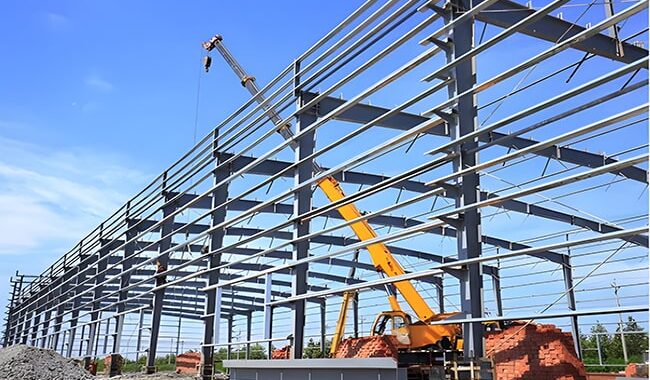In the construction of modern storage facilities, steel structure warehouses have become one of the mainstream building forms due to…
Structural steel is an essential part of the construction industry. Its characteristics include high strength and durability, making it vital in construction projects, bridges, and various infrastructure projects.
What is Structural Steel?
Structural steel is a metal material mainly used for load-bearing components such as buildings, bridges, and engineering structures. It has high strength, toughness, and plasticity and can withstand considerable pressure, bending, and torsion stresses.
The main components of structural steel are iron and carbon, as well as small amounts of elements such as manganese, silicon, phosphorus, and sulfur. The content and proportion of these elements determine the mechanical properties and scope of use of structural steel.
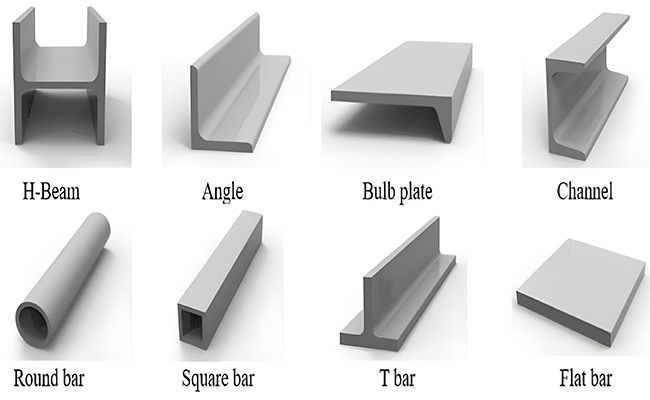
Classification of structural steel:
1. General purpose structural steel: carbon steel
Low-carbon steel contains a maximum of about 0.30 wt% C and about 1.65 wt% Mn. Most rolled steels used for welding are low-carbon steels, and their weldability varies greatly.
For example, most welding processes can weld mild steels with carbon contents less than 0.15% and mild steels with 0.15 – 0.30% C (sometimes called low-carbon steels) up to 25 mm (1 in) thick. However, thicker sections of these steels may require additional measures to weld successfully.
This type of steel is generally called non-alloy or general-purpose steel and is included in the following standards.
Standard
International Standard “ISO630-2Structural steels — Part 2: Technical delivery conditions for structural steels for general purposes.”
European Standard “EN10025-2 Hot rolled products of Structural steels — Part 2: Technical delivery conditions for non-alloy structural steels.”
Chinese Standard “GB/T34560.2-2017_Structural Steel Part 2: Technical Delivery Conditions for General-Purpose Structural Steels.”
Classification of Carbon Steel:
Low Carbon Steel
Low carbon steel is less than 0.25%C, especially 08F, 08Al, etc. with a carbon content of less than 0.10%
Medium Carbon Steel
0.25~0.60%C is medium carbon steel, primarily used in the quenching and tempering state to make parts for the machinery manufacturing industry. Quenching and tempering of 22~34HRC can obtain comprehensive mechanical properties and is easy to cut.
High carbon steel
High carbon steel of more than 0.6%C is mainly used to make springs, gears, rollers, etc.
Low alloy high strength steel
High strength low alloy steel is generally carbon manganese type, with very small amounts of niobium and vanadium added to ensure grain refinement and precipitation hardening.
The design aims to provide better mechanical properties than traditional carbon steels. The yield strength of these steels is generally 290 to 550 MPa (42 to 80 ksi).
Standard
International standard “ISO 630-3:2012 Structural steels — Part 3: Technical delivery conditions for fine-grain
structural steels “N type.
European standard “EN10025-3 Hot rolled products of Structural steels — Part 3: Technical delivery conditions for normalized/normalized rolled weldable fine grain structural steels.”
Chinese standard “GB T 34560.3 Structural steel Part 3 Technical delivery conditions for fine grain structural steels”.
Thermomechanical rolled steels
Thermomechanical rolling was developed to meet the demand for high-strength steels for large-diameter pipelines with good low-temperature toughness and weldability.
The yield strength of these steels reaches 700 MPa (100 ksi) or more. They can generally be welded without preheating. However, preheating may be required at high strength levels to prevent weld metal cracking.
Standard
International Standard: Class M in the “ISO 630-3:2012 Structural steels — Part 3: Technical delivery conditions for fine-grain structural steels.”
European standard “Hot rolled products of structural steels – Part 4: Technical delivery conditions for thermomechanical rolled weldable fine grain structural steels.”
European standard “EN10149 Hot rolled flat products made of high yield strength steels for cold forming.”
Chinese standard: Class M in the “GB T 34560.3 Structural steel Part 3 Technical delivery conditions for fine grain structural steels.”
Quenched and tempered steel
Quenched and tempered steel is heat treated to obtain a yield strength YS of 350 to 1030 MPa.
Welded parts of these materials generally do not require further heat treatment unless post-weld heat treatment (stress relief) is performed in some exceptional cases.
Standard
International standard “ISO 630-4 Structural steels — Part 3: Technical delivery conditions for fine-grain structural steels.”
European standard “EN10025 Hot rolled products of Structural
steels — Part 6: Technical delivery conditions for flat products of high yield strength structural steels in the quenched and tempered condition.”
Chinese standard “GB T 34560.4 Structural steel – Part 4: Technical delivery conditions for quenched and tempered high yield strength structural steels.”
Common types of structural steel:
1. I-beam
I-beam is a rolled iron beam, steel beam, or cast steel beam with an I-shaped cross section, and also refers to a composite beam with an I-shaped cross section.
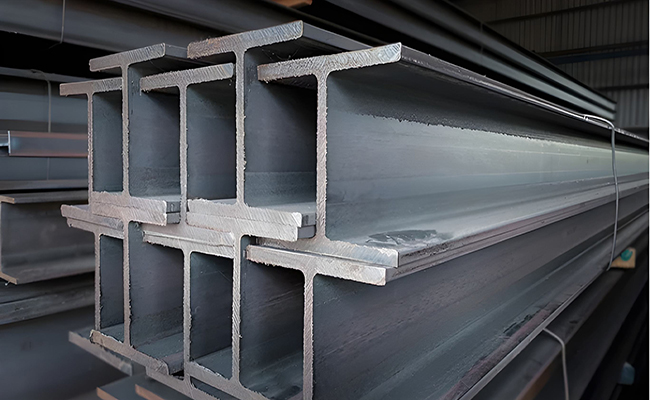
Application field
Building structure: I-beam is often used as a material for building structures such as beams, columns, stairs and platforms
Bridges: I-beams are often used as bridges and parts on bridges, such as railings, beams, columns, and abutments. Its high strength and good bending resistance make bridges more stable and safe.
2. H-beam
The H-beam is an efficient profile with an economical structural cross-section. It requires more optimization of effective cross-sectional area and distribution problems and a more scientific and reasonable strength-to-weight ratio. It is named because its cross-section resembles the English letter “H.”
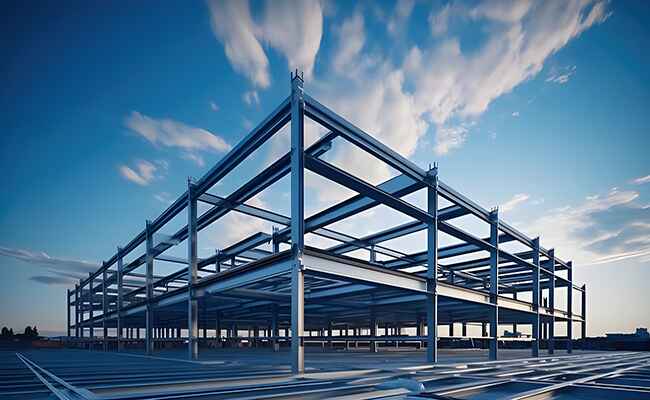
Application field:
H-beam is mainly used for beam and column components in industrial and civil structures, such as steel structure load-bearing brackets of industrial structures, steel piles and support structures of underground projects, industrial equipment structures such as petrochemicals and power, large-span steel bridge components, ship, and machinery manufacturing frame structures, etc.
3. Channel steel
Channel steel is a long steel strip with a grooved cross-section. It belongs to carbon structural steel for construction and machinery. It is a steel section with a complex cross-section and a grooved cross-section. Channel steel is mainly used in building structures, curtain wall engineering, mechanical equipment, vehicle manufacturing, etc.
Application areas:
Channel steel is mainly used in steel structure frames, supporting structures, etc. in the construction field. Its high strength and good plasticity make the building structure more stable and reliable.
4. Angle steel
Angle steel is a long steel strip with two sides perpendicular to each other. There are equal angle steel and unequal angle steel. The two sides of the equal angle steel are equal in width.
Application:
It is widely used in various building and engineering structures, such as beams, bridges, transmission towers, lifting and transportation machinery, ships, industrial furnaces, reaction towers, container racks, and warehouse shelves.
5. T-shaped steel
T-shaped steel has a specific shape and purpose, and its cross-section is T-shaped. Due to its unique shape and performance, this steel is widely used in the fields of construction, bridges, vehicles, ships, and machinery manufacturing.
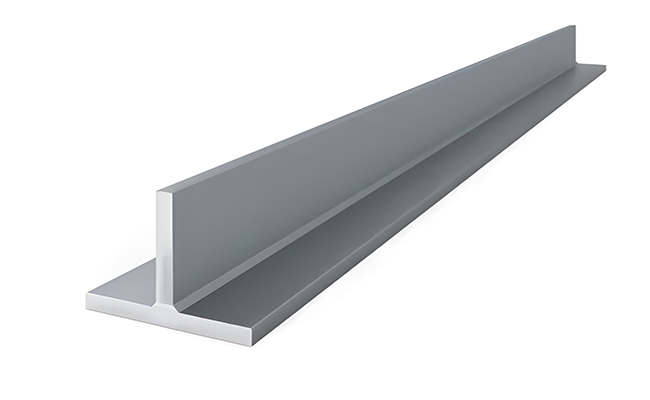
Application fields:
T-shaped steel is widely used in the manufacture of structural components such as beams and columns in the construction field, which can improve the bearing capacity and stability of the building.
6. Circular tube
Circular tube refers to steel with two ends open and hollow concentric circle cross-section, and its length is relatively large compared to the perimeter.
Application:
Can be used for pipelines, thermal equipment, machinery industry, petroleum geological drilling, containers, chemical industry and special purposes.
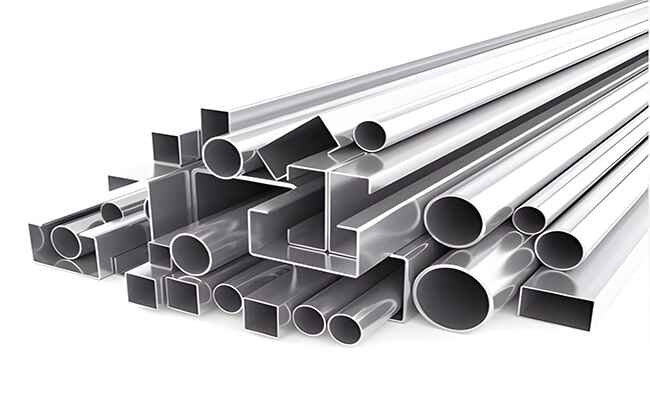
7. Rectangular tube
Rectangular tube is a hollow long strip of steel. When the bending and torsional strengths are the same, the weight is light, so it is widely used in the manufacture of mechanical parts and engineering structures.
Application:
It can be used in construction, machinery manufacturing, steel construction projects, shipbuilding, solar power generation brackets, steel structure engineering, power engineering, power plants, agricultural and chemical machinery, glass curtain walls, automobile chassis, airports, etc.
8. Square tube
Square tube is a tubular material with a square cross section. According to different production processes and uses, square tubes can be divided into seamless square tubes and welded square tubes.
Application:
Square tubes are widely used in the construction field, such as steel structure frames, bridges, highway guardrails, etc. Square tubes have become an important supporting material for modern buildings with their high strength, light weight and beautiful appearance.
9. Flat steel
Flat steel refers to a long strip of steel with a flat cross section. It is characterized by a width much more significant than thickness, and is usually used to manufacture various structural parts, components, etc.
Application:
Flat steel is a common material in construction engineering and is widely used in culverts, columns, beams, walls, etc. It can be processed into different shapes as needed to construct various building structures and improve building safety and stability.
Chemical composition of structural steel:
- Carbon content
The carbon content has a significant effect on the strength and plasticity of structural steel. Generally speaking, the higher the carbon content, the higher the strength, but the plasticity decreases.
Example: Low carbon steel (such as Q235) has a carbon content of ≤0.22%,
Medium carbon steel (such as 45# steel) has a carbon content of 0.42%-0.50%. - Other alloying elements In addition to carbon, structural steel also contains alloying elements such as manganese, silicon, sulfur, and phosphorus, which also have an important impact on the performance of steel. Example: Manganese can improve the strength and wear resistance of steel, and silicon can improve the elasticity and strength of steel.
Property of structural steel:
- Strength
Strength is one of the most essential properties of structural steel, mainly including yield strength and tensile strength. Yield strength refers to the stress value at which steel begins to undergo plastic deformation after being subjected to force. Tensile strength: refers to the maximum stress value that steel can withstand during the stretching process.
Example: The yield strength of Q235 steel is 235 MPa, and the tensile strength is 375-460 MPa. - Plasticity
Plasticity refers to the ability of steel to deform without breaking after being subjected to force. Steel with good plasticity can absorb more energy after being stressed, which improves the safety of the structure.
Example: The elongation of Q345 steel can reach 21%, showing good plasticity. - Toughness
Toughness refers to the ability of steel to resist brittle fracture at low temperatures. High-toughness steel can still maintain good mechanical properties in low temperature environments.
Example: The impact toughness of Q345E steel at -40°C can reach 34 J. - Fatigue property
Fatigue performance refers to the ability of a material to resist fracture under cyclic stress. Fatigue performance is particularly important for steel structures, especially in structures such as bridges and cranes that are subjected to repeated loads.
Example: For Q235 steel, the fatigue limit is about 200 MPa. - Welding property
Welding performance refers to the performance of a material in forming a high-quality welded joint during welding. The quality of welding performance directly affects the reliability and safety of the structure.
Welding crack sensitivity refers to the tendency of a material to crack during welding.
It is usually evaluated by carbon equivalent (CE).
Example: The carbon equivalent CE of Q235 steel is about 0.3%, and its welding performance is good. - Weld joint strength
The strength of the weld joint should not be lower than the strength of the parent material to ensure the overall performance of the structure. Example: For Q345 steel, the yield strength of the weld joint should not be lower than 345 MPa. - Corrosion resistance
Corrosion resistance refers to the ability of the material to resist environmental corrosion. Structural steel is often corroded by the atmosphere, water, chemical media, etc. during use.
Example: Coating protection: Apply anti-rust paint on the surface of the steel structure to form a protective layer.
Processing property of structural steel
- Weldability
Weldability refers to the performance of steel in forming high-quality welded joints during welding. Good weldability is the key to ensuring the quality of structural steel. Example: Q345 steel has good weldability and is suitable for various welding methods. - Cold bending property Cold bending performance refers to the ability of steel to be cold-processed at room temperature without cracking. Steel with good cold bending performance is easy to process into various shapes. Example: Q235 steel has excellent cold-bending performance and is suitable for making cold-bent steel sections.














